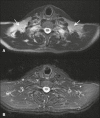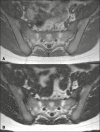Applications of the Dixon technique in the evaluation of the musculoskeletal system
- PMID: 33583975
- PMCID: PMC7869722
- DOI: 10.1590/0100-3984.2019.0086
Applications of the Dixon technique in the evaluation of the musculoskeletal system
Abstract
The acquisition of images with suppression of the fat signal is very useful in clinical practice and can be achieved in a variety of sequences. The Dixon technique, unlike other fat suppression techniques, allows the signal of fat to be suppressed in the postprocessing rather than during acquisition, as well as allowing the visualization of maps showing the distribution of water and fat. This review of the Dixon technique aims to illustrate the basic physical principles, to compare the technique with other magnetic resonance imaging sequences for fat suppression or fat quantification, and to describe its applications in the study of diseases of the musculoskeletal system. Many variants of the Dixon technique have been developed, providing more consistent separation of the fat and water signals, as well as allowing correction for many confounding factors. It allows homogeneous fat suppression, being able to be acquired in combination with several other sequences, as well as with different weightings. The technique also makes it possible to obtain images with and without fat suppression from a single acquisition. In addition, the Dixon technique can be used as a quantitative method, allowing the proportion of tissue fat to be determined, and, in more updated versions, can quantify tissue iron.
A aquisição de imagens com supressão do sinal da gordura é um recurso de grande utilidade diagnóstica, existindo várias sequências capazes de realizá-la. A técnica Dixon, ao contrário de outras técnicas de supressão de gordura, permite suprimir a contribuição do sinal de gordura no pós-processamento e não durante a aquisição, além de permitir a visualização de mapas com a distribuição da água e da gordura. Esta revisão sobre a técnica Dixon almeja ilustrar os princípios físicos básicos, comparar a técnica com outras sequências de ressonância magnética para supressão ou quantificação de gordura, e descrever suas aplicações no estudo de doenças do sistema musculoesquelético. Muitas variantes da técnica Dixon foram desenvolvidas, proporcionando separação mais consistente dos sinais de gordura e água e permitindo correção de muitos fatores de confusão. Permite obter supressão homogênea de gordura, podendo ser adquirida de forma combinada com várias outras sequências, bem como com diferentes ponderações. Esta técnica possibilita também a obtenção de imagens com e sem supressão de gordura a partir de uma única aquisição. Adicionalmente, a técnica Dixon pode ser utilizada como recurso quantitativo, pois permite a mensuração do porcentual de gordura e, em versões mais atualizadas, consegue quantificar ferro tecidual.
Keywords: Dixon technique; Fat quantification; Fat suppression; Magnetic resonance imaging; Musculoskeletal system.
Figures








References
-
- Berglund J. Separation of water and fat signal in magnetic resonance imaging: advances in methods based on chemical shift. Uppsala, Sweden: Uppsala University; 2011.
-
- Pezeshk P, Alian A, Chhabra A. Role of chemical shift and Dixon based techniques in musculoskeletal MR imaging. Eur J Radiol. 2017;94:93–100. - PubMed
-
- Westbrook C, Roth CK, Talbot J. Ressonância magnética: aplicações práticas. 4ª ed. Rio de Janeiro, RJ: Guanabara Koogan; 2013.
-
- Brandão S, Seixas D, Ayres-Basto M, et al. Comparing T1-weighted and T2-weighted three-point Dixon technique with conventional T1-weighted fat-saturation and short-tau inversion recovery (STIR) techniques for the study of the lumbar spine in a short-bore MRI machine. Clin Radiol. 2013;68:e617–e623. - PubMed
-
- Guerini H, Omoumi P, Guichoux F, et al. Fat suppression with Dixon techniques in musculoskeletal magnetic resonance imaging: a pictorial review. Semin Musculoskeletal Radiol. 2015;19:335–347. - PubMed
Publication types
LinkOut - more resources
Full Text Sources
Other Literature Sources
